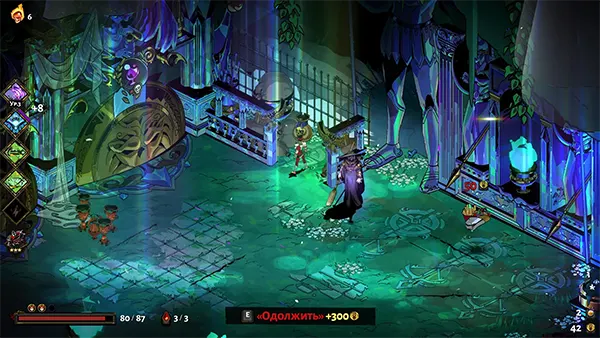
Hades Mobile: how the iconic roguelike performs on smartphones
The arrival of Hades on mobile devices marks an important moment for players who prefer portable gaming without sacrificing depth, responsiveness or narrative quality. The adaptation of Supergiant Games’ award-winning roguelike for modern smartphones needed more than a direct transfer: it required careful optimisation of performance, touch control logic, interface layout and battery efficiency. As of 2025, mobile hardware offers enough power to run demanding action titles, yet only a handful of them manage to retain the precision and pacing that defined their original versions. Hades Mobile stands out as a polished example of how complex, fast tactical gameplay can be translated into a pocket-sized experience.
Performance and technical stability on modern smartphones
Hades Mobile performs consistently well across flagship Android and iOS devices released between 2022 and 2025, maintaining stable frame rates and responsive input during fast-paced encounters. Developers optimised dynamic resolution scaling to ensure the game adapts to different chip architectures, including Apple’s A17 Pro and Qualcomm’s Snapdragon 8 Gen 3, keeping visual clarity high even during large combat sequences. This approach allows the game to remain visually faithful to the original version while avoiding unnecessary thermal stress on the device.
Another important aspect is the game’s memory management, particularly during extended runs that involve multiple biome transitions. On mid-range devices, Hades Mobile uses streamlined asset streaming to minimise loading times and avoid unexpected performance dips. This ensures that longer sessions remain smooth and uninterrupted, which is essential for a roguelike where momentum and rhythm directly influence player success.
Battery consumption, a frequent concern in mobile gaming, has been handled with measurable restraint. Hades Mobile offers performance toggles that allow players to balance battery life and visual fidelity, with a “balanced mode” proving optimal for two-to-three-hour sessions. Thermal throttling is rare on well-ventilated devices, making the title suitable for both casual and extended gameplay without rapid hardware degradation.
Differences between mobile and console versions
Although the mobile edition mirrors the overall structure and content of its console counterpart, some technical differences are inevitable. Texture detail is dynamically adjusted depending on device capacity, and some background effects are simplified to maintain fluid animation. These changes do not affect the overall artistic direction, which remains recognisable thanks to Supergiant’s signature visual style.
Loading segments on mobile are marginally longer than on consoles and PC, particularly when using older storage controllers. Nevertheless, these delays are measured in seconds and rarely disrupt pacing. The game retains its audio richness, including voice lines, combat sound cues and environmental ambience, which play an essential role in navigation and timing during encounters.
Despite minor technical reductions, the mobile version feels complete and reliable. The balance between visual fidelity and system optimisation demonstrates that the developers prioritised playability over strict graphical parity, allowing more players to access the game without compromise.
Touch controls and accessibility features
Translating a fast and reactive combat system to touchscreens is one of the most challenging elements of mobile adaptation, and Hades Mobile takes a deliberate, iterative approach to input design. The developers implemented a dual-thumb layout that mirrors traditional controller mapping, placing movement on the left and attack or dash actions on the right. The responsiveness of this scheme is critical, as even slight delays can disrupt combat rhythm.
The game provides a range of adjustable control options, including custom drag thresholds, button repositioning and gesture-based special actions. These allow players to tailor the interface to personal preference, which is particularly beneficial for those accustomed to physical inputs. Fine-tuning control sensitivity significantly improves consistency during high-intensity battles, where rapid dashes and precise targeting are essential.
Additional accessibility settings include colour-blind modes, automated aim-assist for certain abilities and scalable UI elements. These features broaden the game’s suitability for different playstyles and physical capabilities, reinforcing the idea that mobile gaming can be both inclusive and mechanically robust.
Controller and backbone compatibility
While touch controls are functional, Hades Mobile reaches its full potential when paired with a Bluetooth controller or a specialised mobile gamepad. Modern smartphone operating systems support external devices with minimal input delay, making combat feel closer to the console experience. This is especially true for players who rely on frame-precise actions, such as timing Zagreus’s dash-attacks or weaving cast abilities into fast combos.
Backbone-style controllers offer an ergonomic alternative for users who prefer handheld layouts. These accessories provide tactile feedback and enhance comfort during long sessions, particularly when navigating the more difficult heat levels. Hades Mobile automatically recognises controller input and adjusts on-screen indicators to match the mapped layout.
Thanks to this level of compatibility, the mobile version becomes a versatile option for different environments. Short commutes, relaxed couch sessions or prolonged weekend runs all feel natural depending on the chosen control method, allowing players to enjoy consistent performance regardless of their preferred setup.

Game design integrity and long-term playability
One of the greatest strengths of Hades Mobile is that it preserves the full gameplay structure without removing mechanics or reducing progression complexity. Boons, keepsakes, weapon aspects and heat levels operate identically to the original design, ensuring that players can explore builds with the same depth as on other platforms. The integrity of the core systems remains intact, allowing the mobile version to stand alongside the console editions rather than being treated as a simplified spin-off.
Content updates released prior to 2025, including balancing adjustments and quality-of-life improvements, are already integrated into the mobile build. This ensures consistent meta-progression and familiarity for those who have previously played the game on PC or console. The result is a polished and stable experience that does not feel secondary to other versions.
The game’s narrative delivery also remains unchanged, with all character interactions, branching dialogues and voice acting included in full. Because Hades relies heavily on storytelling woven into repeated attempts, maintaining narrative continuity is essential for emotional engagement. The mobile version handles this effectively, ensuring that the impact of each escape attempt remains just as meaningful.
Suitability for mobile-first audiences
The structure of Hades makes it naturally compatible with mobile habits, as each run is divided into clear segments that can be completed within short play windows. This allows players to progress meaningfully even during brief pauses without feeling pressured to complete an entire session. As a result, the game fits both casual availability and focused playtime.
Cloud save support, where enabled by distribution platforms, allows seamless switching between devices without losing progress. This is particularly useful for players who alternate between smartphones and tablets, as the interface scales cleanly to larger screens. Saves remain stable and synchronised, reducing the friction often associated with mobile gaming continuity.
For those new to the roguelike genre, the mobile version provides an accessible entry point without removing the challenge that defines Hades. The game encourages experimentation and rewards gradual learning, making it suitable for a broad audience while still appealing to experienced players who enjoy refining strategies and optimising builds.
